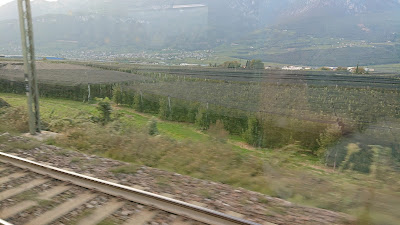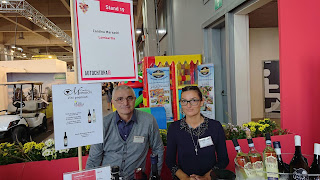Ever been to Bolzano/Bozen? Nor had we. It's a bit out on a limb and there's no currently functioning civilian airport. You have to fly to Verona or Innsbruck and catch a train from there taking anything from 1h 29 to 2h 14. It's not much different by car.
However, we were delighted to find ourselves there for a fair right up our street called Autochtona.
Apologies, this post is going to be on the longer side. We are surprised because Autochtona looked tiny to begin with.
Bolzano as we will call it has a spanking new Exhibition/Fair venue. We had seen the list of exhibitors at Autochtona (63 tables, some shared) and assumed the entire vast space would be given over to the fair.
In fact there were more than one fair going on at the same time. The main one seemed to be something to do with hotels and there was another concerning furniture.
Autochtona was tucked away in what looked by comparison like a small corner.
It was the first day at opening time and things were a little disorganised but there were plenty of visitors there already so we set forth on our quest for the rarest native grape varieties.
On the very first table was a Pelaverga Verduno. We had just become aware of this Piemontese variety and had unearthed a bottle at Jeraboam's and another thanks to Justerini and Brooks in London but it is rare and you could - as we have done - go for years without seeing a bottle or even being aware of the variety. A pity because it is delicious and has an original personality. We think that if have seen it before we might have mixed it up with Pallagrello. This Pelaverga Verduno comes from Verduno and is the same as Pelaverga Piccolo. Pelaverga or Pelaverga Grosso is - wait for it - another unrelated variety. 'Wine Grapes' says Pelaverga Piccolo 'was almost forgotten until a few producers began to craft interesting varietal wines in the 1970s.'
We were off to a good start.
 |
| Tiziana and Silvio Morando at Megavino, Brussels in 2018 |
Things got even better when we recognised Silvio and Tiziana Morando of Azienda Agricola Morando Silvio (Monferrato Casalese) who we had met last year at Megavino Brussels.
There we discovered this Grignolino of theirs which we think is called Anarchico (interesting if anarchic graphics) which is so good we bought another bottle to take home. Sadly that was the only bottle we were able to take back from the fair because all other producers said they had only brought small quantities and could not spare any.
The Morando couple take the prize as the nicest people you can meet in the wine world as well as being exceptional producers.
Silvio took the time to explain the differences (major) between his Bonarda Piemontese and othet Bonardas and Croatina not to mention Uva Rara. Indeed his Bonarda Piemontese could never be mistaken for a Bonarda/Croatina. He also produces Barbera and another Grignolino and a Barbera Grignolino blend.
Now to perhaps the most sensational discovery of the fair (although there were plenty of others as below). At a stand called 'Il Verro' the charming Avenia family had a wine called 'Sheep.'
Enquiring about the grape variety, Cesare Avenia, the paterfamilias
told us it was Coda di Pecora. This was somehow familiar because
there are plenty of Italian wines with Pecora in the name (Pecorino,
Pecorello) and others with Coda (Coda di Volpe) but in fact this Coda di
Pecora is as obscure and as little-known as it gets.
'Wine Grapes' says
it is always blended with other local varieties. D'Agata relegates it
to the 'Little Known and Traditional Grape Varieties' section and says
it 'is used mainly as a blender...on its own it's too meager, neutral,
and flat.'
There is a saying in the musical world that there are no bad orchestras only bad conductors so perhaps the 'conductors' of Coda di Pecora up to now have not been as good as Cesare Avenia because his 'Sheep' was a knockout. Asking if we could buy a bottle, he said it was available in London from Mondial wines who sold it to high-end restaurants. Returning to London we contacted Mondial who seem to be the go-to place if you want native Italian grapes in your wine. They will be the subject of another of our posts for sure.


While on the conductors/orchestras metaphor we should mention this delicious Ciliegiolo we found at the fair. No mention of Ciliegiolo has been made in our 400 plus posts so far because it was never 'our cup of tea' as they say. This one by La Vecchia Posta (Piemonte) very much was. D'Agata pays tribute to Ciliegiolo as 'one of the country's greatest but most underappreciated grape varieties.' He recommends Tuscany and Liguria for the best Ciliegiolos but we can't imagine a better one than this even if it's from Piemonte.
For pure fun, this PetNat from a winery founded only last year called Fra i Monti will take some beating.
Francesco Leone moved from studying Urban Planning to making wine in Lazio and has produced this irresistible wine from Semillon (80%) and Maturana (20%). He told us Semillon was traditional to the area which is very interesting and surprising. In fact we read it was planted there in the 19th century. Francesco also makes a Maturana
in purezza which he is holding above. He looks a little threataning but is only trying to look under his 'flag' at the camera and is a sweet person indeed.
We first heard about Maturana when discovering the Lazio wines of Palazzo Tronconi some years ago. D'Agata tells us it is limited to a small corner of Lazio but was a favourite of D.H. Lawrence. he writes (in 2014) that 'there are producers in Lazio planning to release a monovarietal bottling soon.' This is by no means the first.
Next door we spied Asprinio. If you look up Asprinio in 'Wine Grapes' it says 'See Greco.' Under that heading it explains that 'DNA profiling recently demonstrated that Greco...is unexpectedly identical to Asprinio.' D'Agata says he has a hard time believing that the two are identical' and describes Asprinio as 'most likely deriving from the domestication of wild, local vines thousands of years ago. Asprinio looks and behaves like a wild vine species , with extremely long creepers growng high above the ground between trees ...'
Indeed this photo taken from the gentleman below's mobile shows Asprinio harvesting with the obligatory use of long ladders.
This Asprinio from Aia delle Monache near Caserta was excellent. D'Agata quotes Luigi Veronelli as the source for the idea that Asprinio is the best wine in the world to drink with Pizza.
 |
| The men from Molise. |
Next door was a table with wines from Molise. Their signature variety Tintilia was we now realised yet another situation whereby we avoided a variety in the mistaken assumption that we knew it already. In this case we had been thinking of Tintore, a rare variety from the Costa Amalfitana.
We enjoyed tasting this well made wine and promise never to avoid it again at least on grounds of mistaken identity.
You wait for Incrocio Bruni 54 all your life and then three come along practically at the same time. We reported on Terraquila's version at BING (Best Italian Grape Varieties) Barolo earlier this year and now at Autochtona here were two more.
The Terraquila version had been a great hit with our focus group. It's worth repeating that Sr. Bruni arrived at this crossing only after 53 failed attempts by which time he wanted to have nothing more to do with it. Terraquila were present at Autochtona by the way.
Also at Autochtona was a BING discovery we never imagined to see again so soon: Arvesiniadu. This is completely delicious Sardinian rarity.
Cantina Arvisiniadu (sic) had no less than three versions. The blue label was the basic one from a vineyard near the sea called Goccano hence the play on words G'Oceano.
In the middle was 'Bene Tutti'.
The top tier black label Arvesiniadu was claimed to be he first to have been made using oak.
We asked the nice Arvisionandu man about Quartomoro, the other producer of Arvesiniadu we had met at BING but he professed not to have heard that name before which is strange.
 |
| 14% |
There were sevaral producers who specialised in one variety only. Ferraris's game was Ruche.
 |
| 14% |
 |
| 15% |
 |
| 15.5% |
Ruche has its ardent admirers (Andrew Jefford is one) but it is difficult to make under 14% so
in our opinion there is a danger for it to turn into a fruit bomb.
Another specialist with only one variety on show was Sudtirol Wein with 10 Schiavas (easier to say than Vernatsches). The opposite from fruit bombs.
Our host (above) agreed you can't have too many Schiavas.
We had bought the Sonntaler Vernatsch from Winebuyers.com. If you're looking for a good Grauvernatsch (Schiava Grigio) look no further.
We had noticed in Barolo that Albarossa seemed to be on the up and it was not lacking from Autochtona.
As was Rossese. Always expensive, Rossese is grown on difficult terroir (terraces) and ever fewer people are prepared to carry out the physically demanding work. It would be a disaster to lose this marvellous grape even if quality is variable.
and Groppello. Actually, altough always liking Groppello it hadn't exactly bowled us over but once again to take the conductor/orchestra metaphor, Marsadri's Groppello 'Brolo' was the kind to make you re-evaluate your opinion - upwards.
Pignolo is a grape we have never completely engaged with. This was a good example (even at 14.5%) motivating us to dig deeper.
Verduzzo and Raboso used to be the favourite wines of the Veneziani. Sadly no longer (they go for Pinot Grigio and whatnot apparently).
So we just had to encourage this specialist in both, Bardi. Verduzzo Giallo inclines towards the sweet and there is even a subcategory Ramandolo made from air-dried grapes. We prefer drier Verduzzo which might be Verduzzo Verde or even the more obscure Verduzzo Trevigiano. 'Our' Verduzzo has a peculiar but not unpleasant 'dusty' taste.
Raboso is easier to get a handle on. Indeed we've never had a Raboso we didn't like.
And this 2009er tasted sumptuous from a decanter.
What would Autochtona be without Bulfon - the very definition of autoctonous. The selection on this occasion was Sciaglin, Uccelut and Piculit Neri, all varieties brought back from the brink by Sr. Bulfon. There are many other Bulfon varieties including Cjanorie, Cordenossa and Fumo Rosso. You can find some of them at the UK winemerchant Bat and Bottle and locally in Venice.
To wind up, a dessert wine - what else? Only this one was made amazingly, with Incrocio Manzoni Bianco. Delicious.














































































































